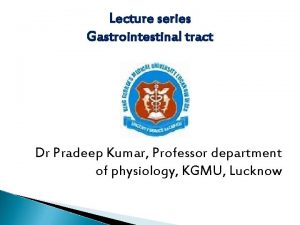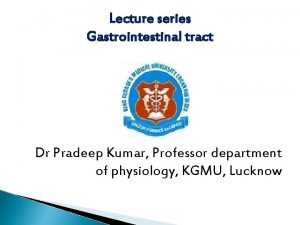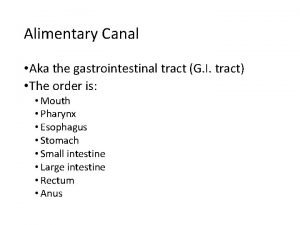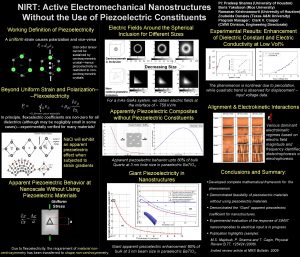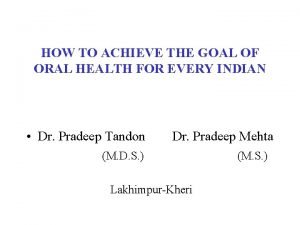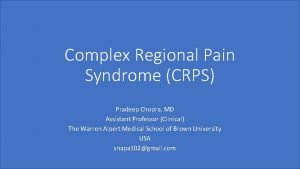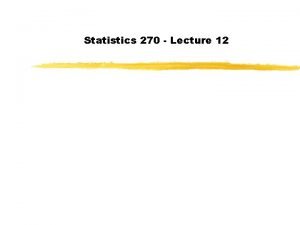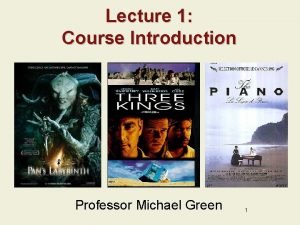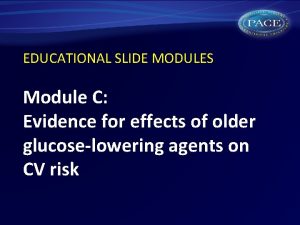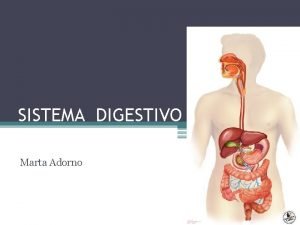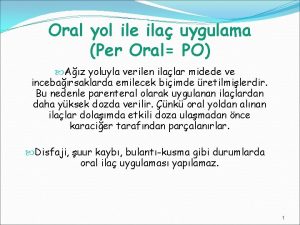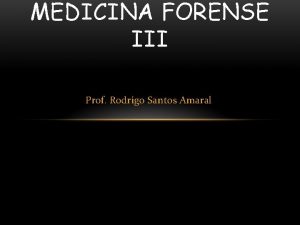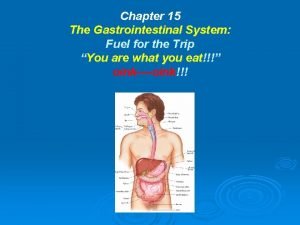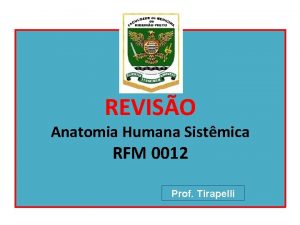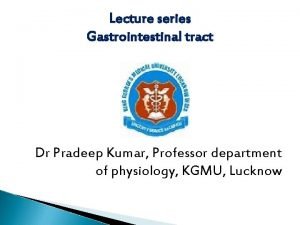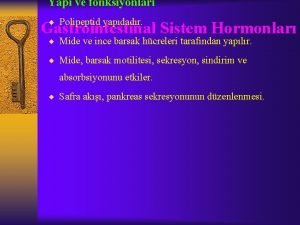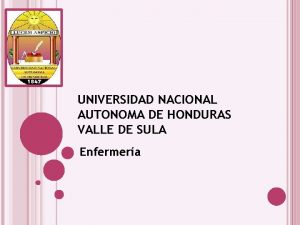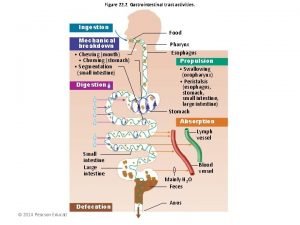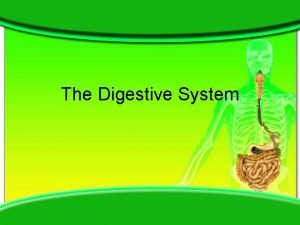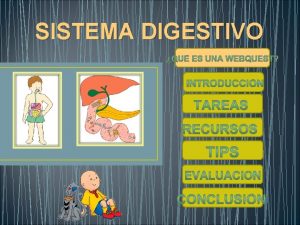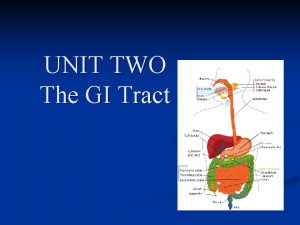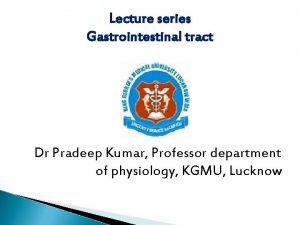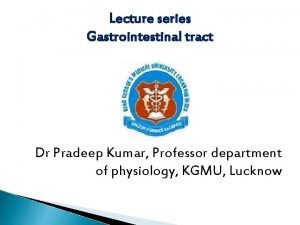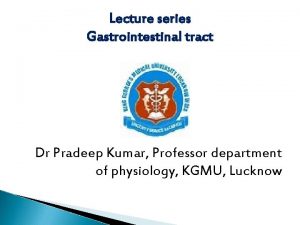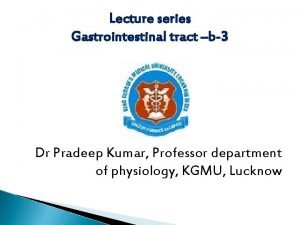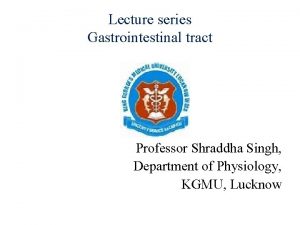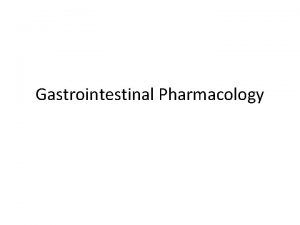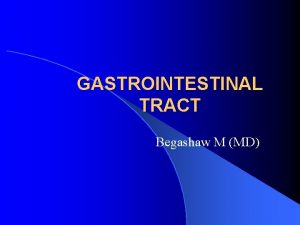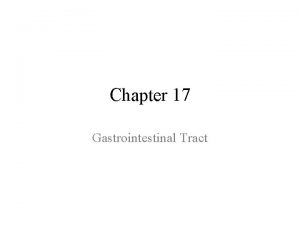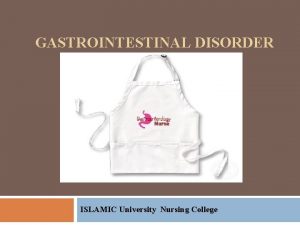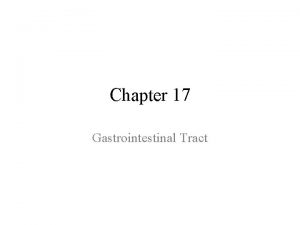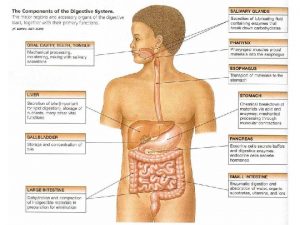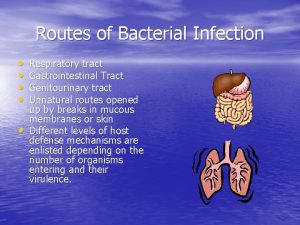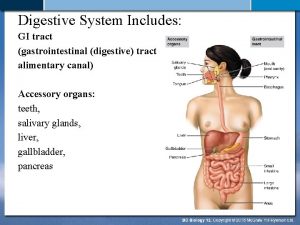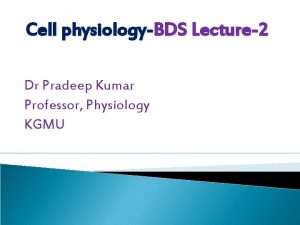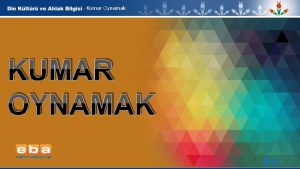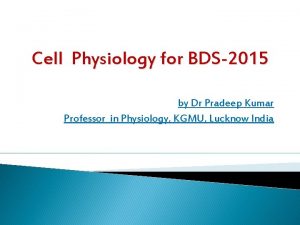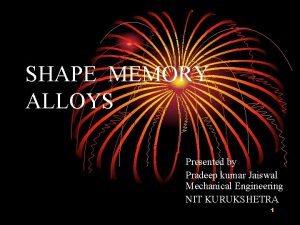Lecture series Gastrointestinal tract Dr Pradeep Kumar Professor



































- Slides: 35

Lecture series Gastrointestinal tract Dr Pradeep Kumar, Professor department of physiology, KGMU, Lucknow

Learning objectives To understand functional significance of gastrointestinal tract (GIT) Understand the structure of GIT and its significance as functional segments Major intestinal secretions

OVERVIEW OF GASTRO-INTESTINAL TRACT Every cell of living system needs energy Unicellular organisms: Exists in the sea of nutrients Can satisfy their nutritional need just by Proteins present at the cell membrane

Multi cellular organisms In multi cellular organisms, a groups of cells converted to a tissue , to perform specific function A number of systems are evolved in vertebrates including humans To provide nutrients to all the systems The Gastro intestinal tract is accounted for extraction of nutrients from the food

The Food The most of the food we eat are macromolecules , it can not cross the cell membrane easily so it must be converted to monomers Gastrointestinal tract is to make the food in absorbable form by help of chewing and by the mixing with various enzymes , in mouth to small intestine

Digestion and Absorption Macromolecules : Food digestive enzymes monomers in small intestine Absorption into blood circulation

GIT is consists of continuous tube which extends from oral cavity to anal canal


Structure of wall of the GIT

Structure of wall of the GIT

Structure of villi

Various secretions from GIT first secretion from git that encounter the food is SALIVARY SECRETIONS

What is saliva Saliva is the mixed glandular secretion which constantly bathes the teeth and the oral mucosa First secretion encounter the food It is vital for oral health It is constituted by the secretions of the three paired major salivary glands; the parotid, sub mandibular and sublingual

Functions of saliva Initiate the digestion of starch Protects oral cavity Ig. A and lysozymes Provide lubrication for food to make bolus Facilitate the taste Helps in speaking, swallowing, chewing Buffer the gastric secretions reflux in to the esophagus

Structure of salivary glands

Parotid gland Parotid Is large accounts for 50% sec. of saliva Situated in front of ear behind the ramus of mandible Gland drain in to oral cavity opposite to second molar tooth Secretions are basically serous

submandibular and sub lingual gland The submandibular gland is about half the size of the parotid gland It lies above the mylohyoid in the floor of the mouth. It opens into the floor of the mouth underneath the anterior part of the tongue The sublingual is the smallest of the paired major salivary glands, being about one fifth the size of the submandibular. It is situated in the floor of the mouth beneath the sublingual folds of mucous membrane.

Structure of salivary gland

Composition of saliva Water 99. 55% solid 0. 45% p. H 7. 04 Na, K, Ca, Mg, Cl, HCO 3 - and phosphate Organic substances includes Ig. A, Lysozymes, albumin, glucose, lactate, urea and ammonia etc. Normal salivary flow rates are 0. 3 -0. 4 ml/min when un stimulated and 1. 5 -2. 0 ml/min when stimulated Approximately 0. 5 – 0. 6 litres of saliva is secreted per day

Control of salivary secretion

Applied The presence of saliva is vital to the maintenance of healthy hard (teeth) and soft (mucosa) oral tissues. Patients suffering from dry mouth can experience difficulty with eating, swallowing, speech, the wearing of dentures, trauma to and ulceration of the oral mucosa, taste alteration, poor oral hygiene, a burning sensation of the mucosa, oral infections including Candida and rapidly progressing dental caries After radio therapy, old age and multidrug therapy

References Lippincott’s Illustrated Reviews: Physiology (2013) Medical Physiology, UPDATED SECOND EDITION (Walter F. Boron, MD, Ph. D) BERNE & LEVY, PHYSIOLOGY, SIXTH EDITION, UPDATED EDITION Ganong’s Review of Medical Physiology, T W E N T Y -F O U R T H E D I T I O N

MCQs

Food stimulates secretion of a) Sublingual salivary gland b) Submandibular salivary gland c) Parotid gland d) Accessory salivary glands

Acini of parotid glands are formed by a) Mucinous cells b) Seromucinous cells c) Serous cells d) Cloudy cells

Which of the following is NOT a component of saliva? A. Alpha-amylase B. Mucin and muramidase. C. Bicarbonate and magnesium. D. Protease and peptidase

which of the following statements about salivary secretion is False (A) saliva contains digestive enzymes. (B) saliva has important antiseptic action. (C) It is largely under hormonal control. (D)It exerts antibacterial action.

If you increase the rate of salivary secretion which of the following changes in ionic composition results? A. Sodium concentration increases. B. Bicarbonate concentration decreases. C. Chloride decreases. D. Potassium increases.

Which of the following best describes type of saliva produced when parasympathetic stimulation increases the rate of salivary secretion? A. Copious, protein-poor, electrolyte-rich. B. Scant, transient protein-rich (mucin), electrolyte poor. C. Scant, protein-poor, electrolyte-poor. D. Copious, protein-rich (mucin), electrolyte-rich.

Sublingual salivary gland is situated a) Under the palatopharyngeous muscle b) Posterior to the mylohyoid muscle c) Below the mylohyoid muscle d) Above the mylohyoid

About salivary glands, which of the following statement is true? (A)Their secretion is mainly under hormonal control. (B)The sympathetic system is the Only natural pathway for stimulation of their secretion. (C)Both sympathetic and parasympathetic nerves stimulate their secretion. D) Bradykinin decrease their blood flow rate.

The presentation of a bolus of solid food to the mouth: (A) stimulates taste buds. (B)Is usually followed by Mastication. (C)Reflexively stimulates The salivary glands. (D)All are correct.

Salivation can become a conditioned reflex . This suggests that: (A)Pleasant taste sensation are not related to the reflex. (B)Only salivatory nuclei in the brainstem need to be excited by taste sensation without participation of suprasegmental influences. (C)The cerebral cortex partially controls salivation. (D) salivation could be completely interrupted in a decorticate animal whose tongue is mechanically stimulated.

Saliva is characterized by all the following except: (A)Its concentration of K+ is the same as that in plasma. (B)Its Na+&Cl- concentration are lower than those in plasma. (C)Its osmotic pressure and PH are lower than their corresponding values in plasma. (D)It exerts antibacterial action.

Thank you
 Cholegogue
Cholegogue Gastrointestinal tract
Gastrointestinal tract Composition of stomach
Composition of stomach Alimentary canal diagram
Alimentary canal diagram Gastrointestinal tract
Gastrointestinal tract Difference between pyramidal and extrapyramidal tract
Difference between pyramidal and extrapyramidal tract Anterior spinothalamic tract
Anterior spinothalamic tract Promotion from assistant to associate professor
Promotion from assistant to associate professor Pradeep sharma university of houston
Pradeep sharma university of houston Dr pradeep tandon lakhimpur kheri
Dr pradeep tandon lakhimpur kheri Dr. pradeep chopra
Dr. pradeep chopra Sushil dubey intel
Sushil dubey intel Pradeep kurukulasuriya
Pradeep kurukulasuriya A college professor never finishes his lecture
A college professor never finishes his lecture Professor green lecture 1
Professor green lecture 1 01:640:244 lecture notes - lecture 15: plat, idah, farad
01:640:244 lecture notes - lecture 15: plat, idah, farad Metformin and constipation
Metformin and constipation Focused physical assessment
Focused physical assessment Emt chapter 18 gastrointestinal and urologic emergencies
Emt chapter 18 gastrointestinal and urologic emergencies Peritônio
Peritônio Sublingual ilaç uygulaması
Sublingual ilaç uygulaması Equimosis colores
Equimosis colores Nursing care for gastrointestinal disorders
Nursing care for gastrointestinal disorders Gastrointestinal embryology
Gastrointestinal embryology Chapter 15 the gastrointestinal system
Chapter 15 the gastrointestinal system Anatomia do rim
Anatomia do rim Gastrointestinal structure
Gastrointestinal structure Gastrointestinal sistem hormonları
Gastrointestinal sistem hormonları Borborygmi
Borborygmi Motilidad gastrointestinal
Motilidad gastrointestinal Gastrointestinal hormones
Gastrointestinal hormones Peristalsis and segmentation
Peristalsis and segmentation Gastrointestinal medical terminology breakdown
Gastrointestinal medical terminology breakdown Embriologia del sistema gastrointestinal
Embriologia del sistema gastrointestinal Gastrointestinal disease
Gastrointestinal disease Gastinoma
Gastinoma
